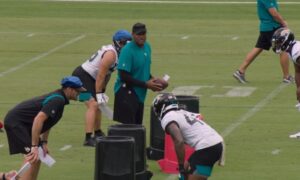The Pittsburgh Steelers have, by and large, been on an upward swing over the course of the past two and a half seasons after they missed the playoffs for two straight seasons, and failed to win a postseason game in four straight years.
Last season saw them gain that elusive playoff victory, though they came up short with about three minutes left in the Divisional round a week later. Their offense took off, and their defense improved, showing playmaking ability and opportunism.
But there are still a lot of unanswered questions facing the team as we crack into free agency territory. As an exercise, we like to take a stab at some of those questions, presenting arguments for the pros and cons of each side of the coin. This is the pessimist’s take on the following question.
Question: Should the Steelers value reward over risk with potential first-round candidates?
As I wrote on this topic yesterday, when it comes to personnel decisions, the Steelers tend to be one of the less adventurous organizations in the league. Sure, they are liable to take a risk every now and then, but if they do, it tends to be a very calculated risk with clear stipulations, as was the case when they drafted Mike Adams in 2012—actual results notwithstanding.
So when it comes to approaching the 2016 NFL Draft and weighing the likelihood of where certain players might fit on the team’s big draft board that you see in the draft day pictures, or indeed if they are even on their board as a draftable player, it tends to skew toward caution, rather than aggressiveness—much unlike their division rivals in Cincinnati, who take on a number of character risks with mixed results.
It is a bit fortuitous that I should write on this topic today, considering the news that came out yesterday that suggests that potential first-round safety—and very possible Steelers target—Karl Joseph may not be physically ready to return to the practice field for the start of training camp, which would obviously be a concern, especially if they had the intention to start him, or at least play him.
Perhaps more importantly, the potential regression of optimism regarding his recovery does no favors to alleviating doubts about a player’s health status and whether or not the potential on-field rewards outweigh the risk that said injury would be a complication in the future.
Another thing to keep in mind with respect to injuries is that the Steelers have had a desire to play their rookies on defense lately, thinking of course of players such as Ryan Shazier, Stephon Tuitt, and Bud Dupree, all of whom entered the starting lineup as rookies—Jarvis Jones was in that category as well. So if they are worried about a player being unable to contribute in the first round, they could shy away.
Other players who might be able to contribute early, but have other concerns outside of the football field, and from a physical perspective, have always tended to be an issue for an organization that aspires to run its business as much as a family enterprise as possible.
There are a number of players over recent years that they could have had the opportunity to draft, but they chose not to due to off-field concerns. I sort of wish that Marcus Peters would have made it to their pick in order to test the theory of whether or not they would have shied away from him, but I suspect that they might have.
Similarly, don’t be surprised if they shy away from somebody like Noah Spence if he falls to the 25th spot in the first round. While my or your opinions on a player might reflect the belief that his past would not be an issue, Pittsburgh has largely held true to a short-hand rule of thumb regarding such conduct.
Recent events within the team’s own locker room, of course, have not helped. The bottom line is, however, that their formula has been largely successful over the years and has been conducive to an energetic and healthy locker room, which is something that they would rightly like to maintain.








